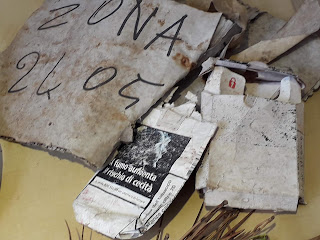2 weeks ago I was in sunny Italy at the Masseria della Zingera in Puglia, on course with Matthew Harris 'You are Here' : Mapping a sense of Place. It was a fabulous stimulating experience in a lovely location in excellent company and I'm still unravelling the processes involved in producing the piece above and beginning to explore how I might apply them to my own developing work. Besides providing insightful ( and sometimes challenging) suggestions throughout the week, based on our individual experiences and preferences, Matthew gave a talk about how he makes his own work. I heard him speak at FoQ last year ( about 'Field Notes' collaboration) but seeing samples in the flesh and hearing more about the thought that goes in to them was fascinating.
We had an extensive list of things to bring and the outline of the workshop - that we would be beginning with drawing using a variety of media , tools and scale to explore ways to respond to the surrounding environment which would form the basis of 2 and 3d dimensional work that reflects a strong sense of personal and environmental place. How it evolved I'll be revealing over a series of blogposts
On the first morning we each went out on walk for an hour - in the grounds and the surrounding roads, being mindful of the experience and collecting things as we did so ( including a large and small stick to be used as drawing implements ) . As part of the walk , we were also to find our 'space' where we would each be working/ recording in and from during the week . There was so much rubbish along the roads ( particularly plastics) I collected examples of that as well as lots of plant material, doing my bit to clean up.
After morning coffee we were each given a 3m long strip of paper and laying them out in the courtyard outside the studio we slowly drew the memory of our walk along the whole length of it using firstly the large stick and an orange ink made from prickly pear (reinforced with a small amount of procion ) and then drew from the other end with a grey ink ( Indian ink diluted 1:8 ) with the smaller stick. Trips to find more stones was required as they took off in the breeze!
We then repeated the process with the scroll of acrylic sized calico Matthew supplied, laying it over the paper for convenience but not tracing the marks, remembering the walk yet again . The size gave the fabric a papery feel but reacted differently.
The next exercise was to put the drawing on paper up on the design board and choose marks to with and make 3d drawings using some of the items we'd collected
I must admit I struggled with this. Besides remodelling a bit of wire I'd found, my main focus was on the ink blots - finding similarities in the holes in walnut shells . Bethan ( fellow Cwilt Cymru exhibiter) was much more imaginative , making a wonderful mobile from grasses based on her marks.
Doing blind drawings on our fabric scrolls of objects by feel alone was far more satisfying - choosing different media to depict varying textures and shapes. I used a fine Pigma pen for a textured metal strip; graphite for a pine cone; a very large Pitt pen marker for a crushed plant pot. I rather regretted the graphite at a later stage when layering colours as it made everything very grubby , should have bought some hairspray as fixitive with me!
We then listed words at the bottom of our drawing on paper about our space and objects to act as prompts and reminders. Among my finds were some old faded cigarette boxes and a tatty piece of cardboard with writing on - what is about foreign handwriting that's so fascinating?
First thing on the second day we were asked to curate our objects, grouping them by type, colour, textures, shape, and then working on our cloth from one end , to draw some of these groups and objects in ink.
The drawings of shibori -like lines of twine, fibre and wire remained my favourite part and I reluctant to alter them until at the last minute on the last day with Matthew's encouragement I finally plucked up the courage to obliterate the marks ( on the basis of being able to repeat and reinstate) . They're still there but hidden among the layers, resulting in a much richer texture.
The main focus of the week however was going to work in our 'space'. We paid a visit there each day , taking our fabric , responding to a series of 6 prompts , chosen by throwing a dice. Later we had the addition of a series of 6 tasks to complete , also selected by throwing a dice, working down the cloth and back again so that you could see the development of ideas. Bethan's space was a popular choice with steps leading up a wall, mine wasn't too far away.I'd been there on the first morning sketching a distant church so it selected itself and the combination of natural and manmade features and viewpoints worked out very well.
On the last afternoon after clearing up we laid the cloths on the floor and discussed the very varied approaches before draping them on the line outside in the glow of the glorious setting sun. Difficult to believe we'd all started out with the same paper,cloth and materials.


















2 comments:
That sunset could win a prize!
oh my goodness - this course sounds amazing, thank you for describing the process you went through so thoroughly.
Post a Comment